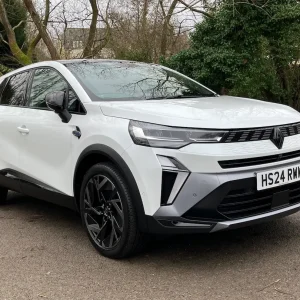Polestar describe these updates for the 2 as an ‘inside out facelift’. Apart from the flush front grille and new 20-inch alloy wheel option, it looks exactly as it did at launch back in 2020. This is no bad thing as the Polestar 2 must be one of the most attractive mid-size EVs already.
The inside is mainly unchanged and again feels better for that. There’s little wrong with the design and feel, it is a step up from any Volvo – although there are more screen and connectivity options.
No, the big changes happen underneath the hatchback body, as the Polestar 2 shares the same Compact Modular Architecture (CMA) as the also recently updated Volvo XC40 Recharge. Just like the XC40, the Polestar single motor has also made the move to rear-wheel drive. This is combined with more powerful electric motors that have been developed in-house for the Polestar 2. We really like the Polestar 2 but, in single motor form, wish for greater efficiency and range – could these updated versions be the answer?
On sale now, with first deliveries in September, we were lucky enough to get early access to the updated 295hp (up from 227hp) single motor recharge with an 82kWh battery. Like the power, torque is increased from 330 to 490Nm, with 0-62 acceleration cut by 1.2 seconds to a very respectable 6.2 seconds.
Experience suggests that the single motor version we have is expected to appeal more to fleets – just! However, there will also be a twin-motor version, now with 416hp and 740Nm.
On top of the new subframe, which we were told, along with subtle changes to the dynamics such as the camber, helps with the change from front to rear-drive, all Polestar 2 models get upgraded batteries.
As a result of these changes, the Polestar 2 Single Motor range goes up to 331 miles, or if you go for the Long Range that jumps to 406 miles, from 343 miles. Choose the Twin-Motor version, and the range increases from 304 miles to 364 miles.
When it comes to recharging, Long Range versions now get a faster maximum charging rate of 205kW, and 135kW for standard range versions. At the time of writing, Polestar hasn’t revealed the charging times from 10-80%, but it claims it charges up to 34% faster.
Within the first couple of minutes of our drive, it becomes obvious that not much has changed with the Polestar 2’s driving experience.
However, like the XC40, when accelerating fast, the rear power bias becomes more obvious with a small spin of the rear wheels when accelerating out of junctions. Plus, slight frontal lift when accelerating hard.
With our single motor model having nearly 300hp, we imagine this will be more than sufficient for business buyers – although we were told there is still considerable fleet business in twin motor versions of the Polestar 2.
Performance is plentiful, acceleration is keen, and it remains the rounded package it has always been.
The ‘one-pedal driving’ mode works well and the handling remains sharp. Although, the new 20-inch wheels contribute to a slightly unsettled ride. It is not bad, but maybe smaller wheels are the answer here.
The move to rear-wheel drive and the fitment of improved batteries appear to have solved the Polestar 2 Single Motor’s questionable range. It remains a neatly detailed, stylish and attractive EV – but we’re not sure it quite has the measure of the BMW i4.
Polestar 2 Long Range Single Motor
P11D: £48,895
Residual value: 54.84%
Depreciation: £22,081
Fuel: £3,919
Service, maintenance and repair: £2,662
Cost per mile: 47.72p
Range: 406 miles
CO2 (BIK %): 0g/km (2%)
BIK 20/40% a month: £16/£32
Luggage capacity: 405 litres
Battery size/power: 82kWh/295hp





